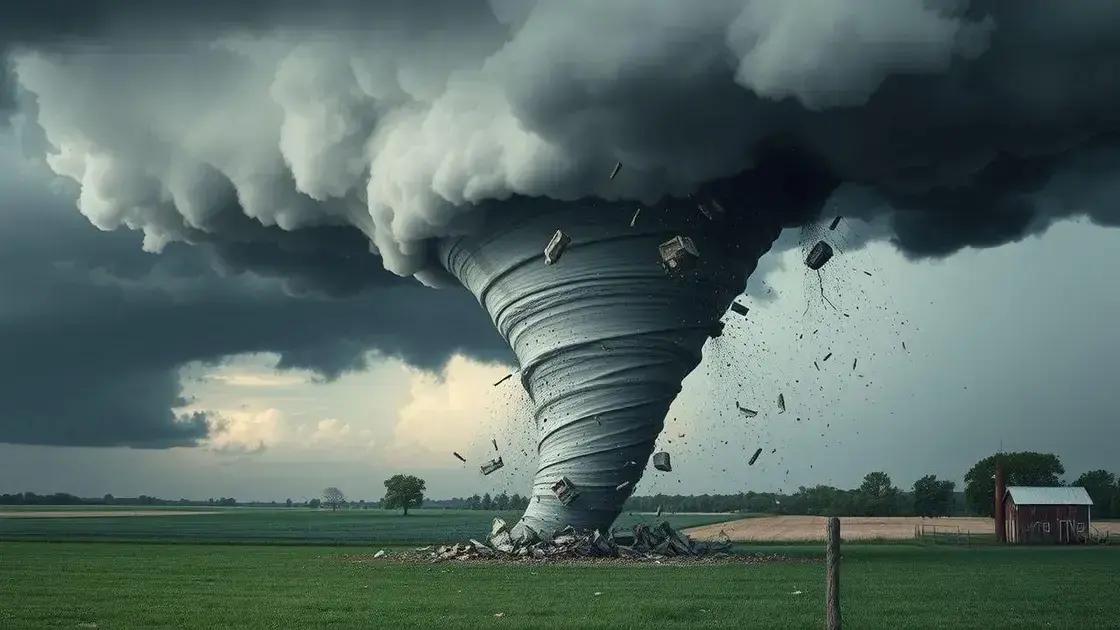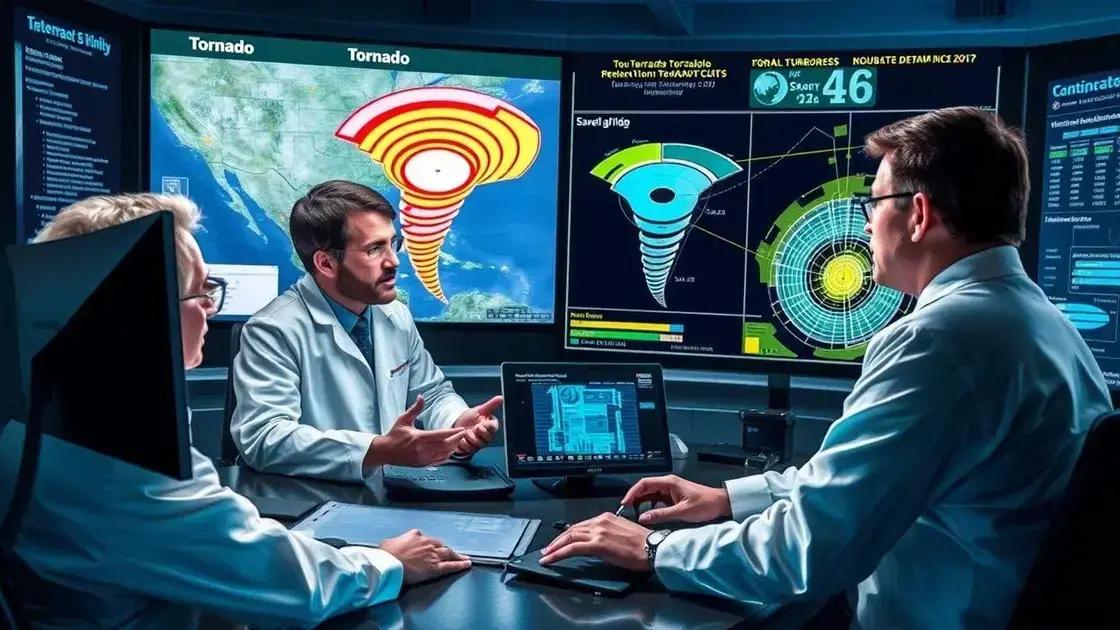Tornado outbreak April 2025: what you need to know

Anúncios
Tornado outbreak activity is influenced by climate change, technological advancements enhance prediction capabilities, and community preparedness initiatives are essential for reducing risks associated with severe storms.
The **tornado outbreak April 2025** caught many by surprise, impacting numerous communities across the country. Have you ever wondered how these natural disasters develop and what you can do to stay safe? In this article, we’ll explore essential insights and updates regarding this significant event.
Anúncios
What triggered the tornado outbreak
Understanding what triggered the tornado outbreak is essential to prepare for future events. Several factors contribute to such natural disasters, making it crucial to pay attention to weather patterns.
Key Factors in Tornado Formation
The main conditions that lead to tornado formation include:
Anúncios
- Warm, moist air: Moist air near the ground provides the necessary lift for storms.
- Cold, dry air: This air often moves in from the north, creating instability in the atmosphere.
- Wind shear: Changes in wind speed and direction with altitude can initiate rotation in thunderstorms.
When these elements come together, they create a fertile environment for supercell thunderstorms, which are often responsible for producing tornadoes. It’s fascinating to see how specific conditions can lead to such powerful weather phenomena.
Weather systems, like cold fronts and warm fronts, play a significant role in this process. A cold front moves into a region, forcing the warm, moist air upwards. This lifting action can lead to the development of severe storms, and when the right conditions are met, tornadoes can form.
Seasonal Influences
The timing of tornado outbreaks often coincides with specific seasons. For instance, spring is notorious for more frequent tornado activity due to optimal weather conditions.
In addition to seasonal patterns, meteorologists also analyze various atmospheric indicators to predict tornado outbreaks. By examining radar data and storm reports, forecasters can better assess the likelihood of tornado development during severe thunderstorm warnings.
Regions most affected by the tornado
Tornadoes can cause widespread destruction, and certain regions of the United States are more prone to experiencing these severe storms. Understanding the areas most affected by tornadoes is vital for preparedness and safety.
Major Tornado-Prone Regions
The following regions typically see the highest frequency of tornado activity:
- Warm Valley: Known for its humid conditions and severe weather patterns, this area often falls victim to powerful tornadoes.
- Southern Plains: States like Texas and Oklahoma frequently experience intense tornado outbreaks due to favorable atmospheric conditions.
- Great Plains: This area, especially parts of Kansas and Nebraska, sees numerous tornadoes each year.
States in these regions must remain vigilant, particularly during peak tornado season, which usually spans from March to June. Meteorologists closely monitor these areas to provide timely warnings and alerts.
In addition to the Southern Plains, the Midwest also accounts for a significant number of tornado events. Illinois, Indiana, and Missouri often report tornado sightings, especially during severe thunderstorm outbreaks. Communities in these states need to stay informed and prepared.
Recent Tornado Activity
Over the past few years, several significant tornado outbreaks have occurred in these regions, leading to substantial damage. It’s crucial for residents in the affected areas to have a clear understanding of notifications and safety protocols.
Residents are encouraged to participate in community drills and stay updated with local weather services. By knowing which regions are prone to tornadoes, individuals can better prepare for severe weather events.
The science behind tornado formation
The science behind tornado formation involves complex interactions between various atmospheric elements. Understanding these processes helps us predict when and where tornadoes might occur.
The Role of Thunderstorms
Tornadoes typically form from severe thunderstorms, especially a type called supercells. These storms are characterized by a rotating column of air that can extend from the base of the cloud to the ground. For a tornado to develop, certain conditions must align.
- Instability: Warm, moist air at the surface combined with cooler, dry air aloft creates instability.
- Lifting mechanism: A weather front or a mountain range can force air upward, creating a powerful updraft.
- Wind shear: Changes in wind speed and direction at different heights can cause the rotating motion necessary for tornado formation.
When these factors come together, they create an environment conducive to tornado formation. The updraft in a supercell can become strong enough to organize the rotation, forming a tornado.
Key Elements of Tornado Development
Several critical elements contribute to the birth of a tornado. These elements work together in combination, leading to the development of a tornado:
- Cumulonimbus clouds: These are the towering clouds associated with thunderstorms. They create an ideal setting for tornadoes.
- Mesocyclone: This is a rotating updraft within the supercell, which can spawn a tornado.
- Downdrafts: Cool air descending can interact with warm air at the surface, adding to the storm’s intensity.
Understanding the science behind tornado formation assists meteorologists in predicting severe weather events. By studying atmospheric conditions, they can provide early warnings, potentially saving lives.
Emergency preparedness tips for tornadoes

Being prepared for tornadoes can save lives and minimize damage. Understanding what to do before, during, and after a tornado is crucial for everyone.
Before a Tornado
Preparation is key to staying safe. Here are some essential steps to take:
- Create an emergency kit: Include water, non-perishable food, a flashlight, batteries, a first-aid kit, and important documents.
- Have a plan: Designate a safe location in your home, such as a basement or an interior room without windows.
- Stay informed: Keep watch for weather alerts on your phone or through local news.
Preparation should also involve communicating with family members about the plan. Make sure everyone knows what to do if a tornado warning is issued.
During a Tornado
If a tornado warning is issued, take action immediately. Seek shelter in your designated safe area, and protect yourself from debris.
- Get low: Crouch down and cover your neck and head with your arms.
- Stay away from windows: Flying glass can cause serious injuries during a tornado.
- Listen for updates: Use a battery-operated radio or your mobile device to stay informed about the storm’s progress.
While in your safe area, stay quiet to hear updates, and don’t leave until authorities have declared it safe.
After a Tornado
Once the tornado has passed, be cautious as you assess any damage. Here are some tips for what to do next:
- Check yourself and others for injuries: Attend to any injuries and seek medical help if needed.
- Stay away from damaged areas: Avoid downed power lines and unstable structures.
- Report hazards: Call emergency services to report dangers like gas leaks or blocked roads.
Being prepared can make a significant difference in your safety. Knowing what to do all throughout the tornado process can help ensure that you and your loved ones remain safe.
How to stay safe during a tornado
Staying safe during a tornado is crucial. Knowing what to do in the moments leading up to and during a tornado can make a significant difference in your safety and well-being.
Finding Shelter
Your first step is to find a safe place. Basements are the safest, but if you don’t have one, move to an interior room on the lowest floor.
- Avoid windows: Stay away from glass to prevent injuries from flying debris and broken glass.
- Go low: Crouch down near the floor and protect your head and neck with your arms.
- Use a mattress: If you have a mattress or heavy blankets, use them for extra protection against debris.
Many people think they can outrun a tornado in their car, but this is dangerous. It is better to stay put and find shelter.
Staying Informed
While in your shelter, remain updated on the weather. Use a battery-operated radio or your smartphone to listen for tornado updates.
- Listen for alerts: Pay attention to official warnings and updates from your local weather service.
- Stay in your shelter: Wait until officials have declared that it is safe before leaving your protected area.
- Be aware of your surroundings: After the storm passes, be cautious of potential hazards like downed power lines or damaged structures.
Staying safe means being prepared and informed. Following these guidelines can help you navigate a tornado risk better.
The aftermath of tornadoes on communities
The aftermath of tornadoes can be devastating for communities. Rebuilding and recovery take time and effort, affecting everyone involved.
Destruction and Damage
When a tornado strikes, it leaves behind a path of destruction that can completely change landscapes and homes. Here are some of the most common effects:
- Structural damage: Buildings, homes, and infrastructure may be heavily damaged or completely destroyed.
- Displaced families: Many families may lose their homes, forcing them to seek temporary shelter or long-term housing solutions.
- Economic impact: Businesses can be damaged or forced to close, impacting local economies and jobs.
Such destruction can create a sense of loss and uncertainty for those affected. Communities must come together to support one another during these difficult times.
Community Response and Recovery
After a tornado, communities often spring into action to help those in need. Local organizations, volunteers, and government agencies work together during recovery efforts.
- Emergency services: First responders provide immediate help to those in danger, ensuring safety and health.
- Relief efforts: Nonprofit organizations and community groups organize food, shelter, and supplies for affected individuals.
- Long-term recovery plans: Local governments develop plans to rebuild infrastructure and support economic recovery.
With community resilience and support, people can begin to heal from the physical and emotional scars left by the tornado. Engaging in community activities and supporting local businesses can foster recovery and hope.
Lessons learned from past tornado outbreaks
Lessons learned from past tornado outbreaks help communities and meteorologists improve safety measures and response strategies. By studying previous events, we can develop better preparedness plans.
Improved Warning Systems
One of the most significant advancements has been in warning systems. Technology continuously evolves, enhancing how we receive alerts. Some key improvements include:
- Real-time updates: Meteorologists can track storms in real-time, providing timely warnings.
- Mobile alerts: Many communities have adopted SMS alerts, ensuring that more people receive notifications during severe weather.
- Community sirens: Outdoor warning systems have become more common, alerting individuals outdoors to seek shelter immediately.
These improvements have saved lives by ensuring that people have the information they need to react quickly.
Preparedness Training
The importance of community preparedness has become increasingly clear after major tornado events. Training exercises play a vital role in readiness. Organizations often hold drills that teach:
- Evacuation procedures: Understanding where to go and how to exit buildings safely is crucial during a tornado.
- Emergency plans: Families learn how to create effective emergency plans for their specific environments.
- First aid skills: Knowledge of basic first aid can make a significant difference in emergencies.
Communities that actively participate in preparedness training are generally better equipped to respond effectively during actual tornadoes.
Building Codes and Standards
After several destructive tornado outbreaks, many regions have updated building codes to reduce damage from future storms. Stronger structures can withstand tornado winds better. Some changes include:
- Stronger materials: Builders are encouraged to use materials that can endure higher wind speeds.
- Design improvements: New designs focus on minimizing damage to roofs and walls.
- Community shelters: Many areas now have dedicated storm shelters that meet safety standards.
These lessons show that through evaluation and change, it’s possible to enhance safety and resilience against tornado outbreaks.
Future predictions for tornado activity

Future predictions for tornado activity are becoming increasingly important as climate conditions change. Scientists use data from past tornadoes to make forecasts.
Climate Change Effects
One of the biggest factors influencing future tornado activity is climate change. Rising temperatures and changing weather patterns may lead to:
- Increased severity: More intense storms could result in stronger tornadoes.
- Shifts in timing: Tornado seasons may start earlier and last longer due to varying weather conditions.
- Geographical changes: Regions not traditionally known for tornadoes may see more activity.
These changes require communities to adapt their preparedness plans to reflect new risks associated with tornadoes.
Advancements in Technology
As technology progresses, our ability to predict tornadoes improves. Enhanced radar systems and computing power allow meteorologists to:
- Analyze patterns: Studying storm systems in real-time helps in predicting possible tornado formations.
- Improve modeling: More accurate weather models lead to better long-term forecasts.
- Issue more timely warnings: Faster technology means quicker alerts to those in the danger zone.
With these advancements, communities can be better informed and prepared, reducing the impact of severe tornadoes.
Community Preparedness Initiatives
Looking ahead, communities need to enhance their preparedness initiatives. This involves ongoing education and training for residents. Key strategies include:
- Public awareness campaigns: Teaching residents about tornado safety and warning signs is vital.
- Emergency response drills: Regular practice of emergency procedures helps people react quickly during a storm.
- Collaboration with meteorologists: Partnering with local weather services can improve preparedness resources.
By implementing these strategies, communities can empower residents to respond effectively when tornadoes occur.
FAQ – Frequently Asked Questions about Tornado Preparedness and Safety
What should I do before a tornado strikes?
Before a tornado, create an emergency plan, prepare a safety kit, and identify a safe place in your home, like a basement or an interior room.
How can I stay informed during a tornado?
Stay informed by listening to weather alerts on the radio or using weather apps on your phone to receive real-time updates.
What are the best practices for safety during a tornado?
During a tornado, seek shelter in a safe place, avoid windows, and protect your head and neck with your arms or a sturdy object.
How can communities prepare for future tornadoes?
Communities can prepare by organizing drills, improving emergency response plans, and fostering public awareness about tornado safety.






